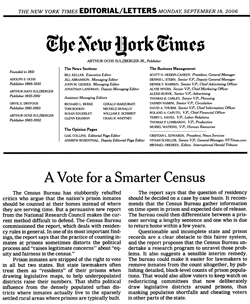New tool shows how prisons skew county demographics
by Peter Wagner, October 20, 2006
The Prison Policy Initiative frequently receives requests from people in rural counties asking for data showing how the Census Bureau’s method of counting people in prisons skews county demographics. Even though prisoners cannot participate in the local community, the Census Bureau nevertheless counts them as residents of the county where they are incarcerated. We have published a number of national maps illustrating the problem and have posted tables showing some of the extreme cases, but we have never made the underlying data available to the public.
Today, the Prison Policy Initiative rolls out a new addition to our groundbreaking April 2004 report, Too big to ignore: How counting people in prisons distorted Census 2000: interactive data tables. The report’s findings include the discovery that 21 counties have at least 21% of their Census population behind bars, and that in 173 counties, more than half of the Black population is incarcerated.
Continue reading →
 The Census Bureau has stubbornly rebuffed critics who argue that the nation’s prison inmates should be counted at their homes instead of where they are serving time. But a persuasive new report from the National Research Council makes the current method difficult to defend. The Census Bureau commissioned the report, which deals with residency rules in general. In one of its most important findings, the report says that the practice of counting inmates at prisons sometimes distorts the political process and “raises legitimate concerns” about “equity and fairness in the census.”
The Census Bureau has stubbornly rebuffed critics who argue that the nation’s prison inmates should be counted at their homes instead of where they are serving time. But a persuasive new report from the National Research Council makes the current method difficult to defend. The Census Bureau commissioned the report, which deals with residency rules in general. In one of its most important findings, the report says that the practice of counting inmates at prisons sometimes distorts the political process and “raises legitimate concerns” about “equity and fairness in the census.” 


